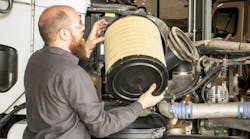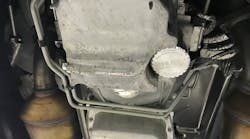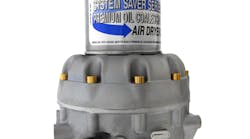A vehicle filter, regardless of the system it’s protecting, is designed to capture particles and debris before those contaminants make their way into the system.
Filtration management and replacement is an integral part of any fleet’s preventative maintenance (PM) program. While change intervals may seem straightforward, updates to proper maintenance processes have been dictated by advancements in fluid and filter technology.
Different filters found on a heavy duty truck protect the following systems: engine oil, fuel (both on-vehicle and bulk storage), engine air intake, crankcase ventilation, emissions, cabin air, hydraulic systems, transmissions, coolant systems and more.
Combined overall, there may be dozens of filters for these different systems for any given truck. While all are vital to proper filtration throughout various vehicle systems, some are monitored and replaced more frequently.
In particular, when it comes to any type of filtration directly or indirectly protecting the engine, these filters require added monitoring and more frequent changes. Specifically, engine oil, fuel system and air intake system filtration all require the most frequent and extensive monitoring.
ENGINE OIL FILTERS
“The (engine oil) filter has one function, and that is to filter contaminants from the oil,” says Zafar Hussain, senior product engineer for Luber-finer, a filter supplier for Class 5 through 8 vehicles. The removal of these contaminants helps fleets avoid unnecessary wear on the heavy duty engine.
There have been a number of updates to engine oil maintenance practices in recent years, especially due to the changes with the U.S. EPA’s greenhouse gas emission requirements.
Trends in engine oil filtration
Heavy duty truck engine performance and fuel efficiency have been improved with the December 2016 introduction of API category CK-4 and FA-4 engine oil standards. These lower viscosity synthetic engine oils were designed to meet 2017 model year on-highway greenhouse gas (GHG) emission standards, and help improve exhaust aftertreatment system durability. These updated engine oil specs are formulated to work with engines using low-sulfur diesel fuels.
It is important to note, CK-4 is backwards compatible with older engine systems, and is suitable for diesel fuel systems with sulfur content ranging from 15 ppm to 500 ppm. FA-4 engine oil should only be used for engines operating with diesel fuel with a sulfur content at or below 15 ppm.
“Today’s engine lubricants contain better contaminant control properties and are actually providing fuel economy gains, all of which translates to lower contaminants present in the lube system,” says Jared Gwin, product management and planning director for Cummins Filtration. Known for their Fleetguard brand of filter products, Cummins Filtration is a wholly owned subsidy of Cummins Inc.
“There is also some evidence suggesting that synthetic oils do not break down as much under heat, which is a reason why many OEMs are using synthetic blends today,” Gwin adds.
With the increased efficiency of synthetic engine oil blends, the concern is no longer the filter's ability to capture soot and contaminants. Rather, it’s the necessity for the filter and media to last as long as, or longer, than the engine oil before servicing.
“Filter manufacturers have responded to evolving needs of OEMs with the release of synthetic filter media formulations that deliver higher efficiency, lower pressure drop and higher capacity,” says Jason De Guelle, product manager, engine liquid filtration for Donaldson Filtration Solutions. Donaldson provides a range of filter solutions for light, medium and heavy duty vehicles.
In addition to filter media, the construction of the entire filter has been updated. Features such as seamless steel shells, spiral cores and vibration-resistant gaskets have all helped provide extended engine protection, according to Luber-finer’s Hussein.
With engine oil and filtration staying on the vehicle longer, Donald Chilton, director of product management at WIX Filters, notes it’s important to also monitor oil degradation. WIX Filters makes filters for Class 1 through 8 on- and off-highway vehicles.
“The modern engine is fairly clean when it comes down to it, so there’s not a lot of contamination that gets in there,” Chilton explains. “As the oil starts to break down, that’s where the contamination and the capacity of the filter has to increase.
“In the past, you may have a full cellulose type media that would be able to handle the 20,000 miles no problem. Now you’re getting into the blended-synthetic or full-synthetic type media to be able to handle that 50,000- or 60,000-mile change interval.”
When it comes to bypass versus full flow filtration systems, filter suppliers say full flow systems are the norm on newer engines.
Bypass filters were designed to aid in additional soot removal for older engines. With the development of more efficient engines and implementation of EPA GHG standards, bypass filters provide no added benefit to modern engine systems, according to Chilton.
“Especially with the ULSD and all the different emission control [regulations] out there today for crank case ventilation, DPF setups [and] all the things going on in the Tier 4 and 5 engines, [bypass filters] really don’t add any benefit anymore,” he says.
Optimizing change intervals
Traditionally, heavy duty trucks used to require an engine oil change about every 15,000 to 20,000 miles. With the introduction of synthetic oils and filters to address needs in improving fuel efficiency, OEMs now recommend 50 to 65 percent longer oil drain interval.
“Most of today’s Class 8 trucks experience a normal duty cycle which places them in a typical range of 30,000- to 45,000-mile oil drain intervals,” says Cummins Filtration’s Gwin. It is important to note, these intervals are contingent on OEM service requirements and the vehicle’s general operating duty cycle. It is always recommended, first and foremost, to review OEM guidelines.
While recommended oil change intervals provide a recommended baseline for maintenance scheduling, any number of variables including vehicle application, geographic location, driver behavior and quality of fluids and filters can impact the life of the engine oil and filter.
To determine maintenance intervals, a comprehensive fluid analysis program for the specific system being evaluated can provide insights into the current status of the fluid, and subsequently, the filter productivity.
For example, Cummins Filtration offers their OilGuard program for select Cummins engines, to determine the viability of extending drain intervals without voiding the engine warranty. An assessment is conducted on a sample set of test vehicles in the fleet. The program reviews engine data and oil analysis from a minimum of two oil changes. “For example, fleets desiring an 80,000-mile oil change interval will be required to submit samples every 10,000 miles,” according to marketing materials from the company.
In general, for any oil analysis program, it is recommended fleets work with their filter or oil suppliers throughout the process to ensure appropriate methods for oil sampling and other tests are conducted, as well as ensure the factory warranty isn’t compromised.
“Any decision to extend oil drain intervals must be based on oil analysis and adherence to OEM criteria for acceptable oil operating properties, which may include, but are not limited to: TBN, soot, viscosity and fuel dilution,” Luber-finer’s Hussein explains.
If an analysis confirms oil change intervals can be extended, it is important to note there are engine oils and filters designed specifically for this purpose.
“Not all filters are designed for extended life,” Gwin says. “Attempting to run a filter that does not have extended service interval capability can lead to decreased engine protection and performance over time.”
FUEL FILTERS
Shortened filter life can be frustrating, but can be indicative of a larger issue with the fluids or vehicle system itself.
“A fuel filter that is plugging quickly is protecting those precision fuel system components from harmful contamination that can cause premature wear of expensive fuel injectors, preventing decreased fuel economy and reduced engine performance over time,” Cummins Filtration’s Gwin explains.
Conversely, he confirms an unclogged filter doesn’t necessarily mean it isn’t ready to be replaced.
“The common misconception is that if the filter is not plugging, it does not need to be changed when, in reality, the filter may not be removing contaminant to protect the engine over time as it should.”
Just like an oil analysis kit works to test engine oil performance, when it comes to fuel analysis kits, these products work well to determine the condition of the fuel.
Combating water contamination
When it comes to fuel analysis, there are additional variables to consider, compared with engine oil analysis. This is due to the potential inconsistencies of fuel due to how and where it’s processed, the transport of the fuel, the storage of the fuel and the geographic location of the fleet, etc.
Specifically, water contamination is the main factor affecting fuel system filtration.
It is particularly challenging to address water contamination with the more widespread adoption of ultra-low sulfur diesel (ULSD) and biodiesel use, due to the issues with water separation with these types of fuels.
Donaldson’s Du Guelle advises byproducts of biodiesel blend production in particular – namely glycerols, and more specifically glycerin – can be detrimental to a fuel system and subsequent filtration.
“They won’t cause immediate problems as long as they remain warm and in liquid form," De Guelle says of glycerin. “At low temperatures, however, glycerin assumes a solid waxy state where it can drop to the bottom of tanks, get caught in fuel filters and form sticky, corrosive engine deposits. Ultimately, these deposits can immobilize a fleet.”
To address this issue, he recommends using biodiesel blends with lower glycerin levels.
While ultra-low sulfur diesel has helped fleets meet current emission regulations, use of this fuel is also not without additional challenges.
“The reduction in the sulfur content of diesel fuels has resulted in low lubricity problems which leads to increased wear of engine components,” Cummins Filtration’s Gwin explains.
There are fuel filters available which include “lubricity-enhancing additives” with a controlled release, says Gwin. “The release mechanism is designed so that the lubricity enhancer will be added to the fuel till the end of filter life, thereby reducing wear of engine components over time.”
In addition, the filtration process for ULSD has become more challenging.
“It used to be with oil and water, you pour [fuel] in [the tank], it mixes up and then you can come back in a couple hours and see where it’s separated," WIX Filters’ Chilton says of traditional diesel fuels. "The oil and water would be clearly separated where the water is on top. ULSD doesn’t allow the oil and water to separate the way it should, where it’s clear like that. You have this constant mix of water in the diesel fuel, where it’s so much harder from a filtration standpoint to actually separate it.”
To combat this issue, Chilton advises specialized, multi-stage synthetic filtration media is needed to extract water and other contaminants from the fuel.
This type of filtration media is used both on the vehicle, and for bulk storage filtration.
“Generally speaking, a well-maintained fuel storage system will allow the owner to change the dispenser filter every six months or 500,000 gallons,” Luber-finer’s Hussein says. “However, if fuel flow becomes prematurely restrained as the filter collects particulate, and this condition occurs earlier than planned maintenance intervals, then it is likely an indication of a serious contamination problem within the fuel storage system.”
Proper and frequent monitoring of the state of fuel in storage tanks can help identify issues as they arise, allowing fleets to address them immediately before irreparable damage occurs to vehicle components or systems.
Donaldson’s De Guelle advises to combat contamination before water or other particles enter the storage tank, fleets can invest in high-efficiency filtration products designed for use before the fuel enters the storage tank upon fuel delivery. In particular, fleets operating model year 2013 or newer high-pressure common rail engines or that may be experiencing fuel quality issues showing up as lift pump or injector failure, or premature on-board fuel filter plugging, would be ideal candidates for these products.
For fleets that do not maintain bulk storage on-site, there are still products available to optimize the performance of fuels and remove water and other contaminants.
“Basically, it sucks the water out of the fuel so you don’t have to worry about it," Chilton explains. "It’s a cheap insurance policy to keep your fueling system in proper working order.”
AIR INTAKE FILTERS
Air intake filters allow clean air to flow into the engine chamber to aid in the combustion process. It is imperative this air have the least amount of particles possible. Contamination can cause increased engine wear, a reduction in engine performance and potential vehicle downtime. When it comes to air intake filters, filter suppliers overall suggest dry air intake filters compared to oiled options.
“Dry media typically gives the optimum combination of high efficiency, low initial restriction and long life,” Donaldson’s De Guelle says. “While oiled filter elements have the potential to provide long filter life, they can present issues with overall particle separation efficiency as well as other problems.”
It is always recommended by the OEM and filter suppliers alike to replace the filters rather than clean them.
“There is a risk of dirt reaching the clean side of the filter while cleaning, plus possible filter damage from high pressure water or compressed air, making cleaning or washing a gamble,” De Guelle says.
Air filters should be monitored and serviced based on airflow restriction levels in the intake system, he adds.
“It is common in the industry for maintenance shops or operators to remove and clean air filters with air hoses or by knocking them against the ground or another object,” Cummins Filtration’s Gwin says. “These practices are very likely to damage the air filter element in such a way that it compromises the ability of the air filter to perform as intended. A tear or rip in the filter media can lead to dust particles and other contaminant passing directly through the filter and downstream into the engine where it can cause severe engine damage. As little as 100 grams of dust is enough to ruin a heavy duty engine.”
To monitor air intake filter performance, Luber-Finer’s Hussein advises fleets can use an air filter restriction gauge.
“It’s a smart, low-cost investment that gives you an accurate representation of air filter performance,” he says.
Hussein also says during the filter replacement process, it is important to always clean the air intake housing and gasket sealing surfaces after the used filter is removed and before installing the new filter.
“Dirt left in the air cleaner housing can damage your engine, and an improper gasket seal is one of the most common causes of engine contamination,” he adds.
Monitoring systems for filtration performance
When it comes to consistent monitoring of filters, a number of companies have introduced products to help continuously monitor different filtration systems. Cummins Filtration offers the FleetguardFIT (Filtration Intelligence Technology) to closely track engine oil filters, and WIX Filters offers the Senzit for air intake filtration monitoring.
“FleetguardFIT works through integrated sensors, a control module and engine parameters that use existing telematics to transmit real-time information about how your filters and engine are performing,” Cummins Filtration’s Gwin explains.
This information is available for the fleet to access at any time. The monitoring system can provide status alerts with recommended actions, and advise fleets on the next suggested service interval that coincides with other service to optimize vehicle uptime. This approach also allows the customer to pinpoint system failure mechanisms and potentially prevent catastrophic engine damage.
When it comes to air intake filters, vacuum gauges have been the norm for monitoring performance and status on when to change the filter. WIX Filters recently introduced a smartphone app providing fleets and drivers the ability to monitor the air filter in real-time. This product is not able to be integrated into maintenance management programs at this time.
“Currently, Senzit does not integrate with in-shop software. However, in addition to the mobile app, the Senzit web portal enables quick and easy viewing of all Senzit devices within an entire fleet. Within this format, fleet managers can view maintenance status, predict order schedules, etc.,” explains Chilton.
Conclusion
Whether using continuous monitoring devices, or implementing comprehensive PM scheduling to monitor filter performance, fleets should consider fluid analysis programs and up-and-coming trends in the industry to optimize the variety filtration systems on a vehicle.
“Simply put, improved filtration can lead to longer sustained engine performance and life,” says Cummins Filtration’s Gwin.







